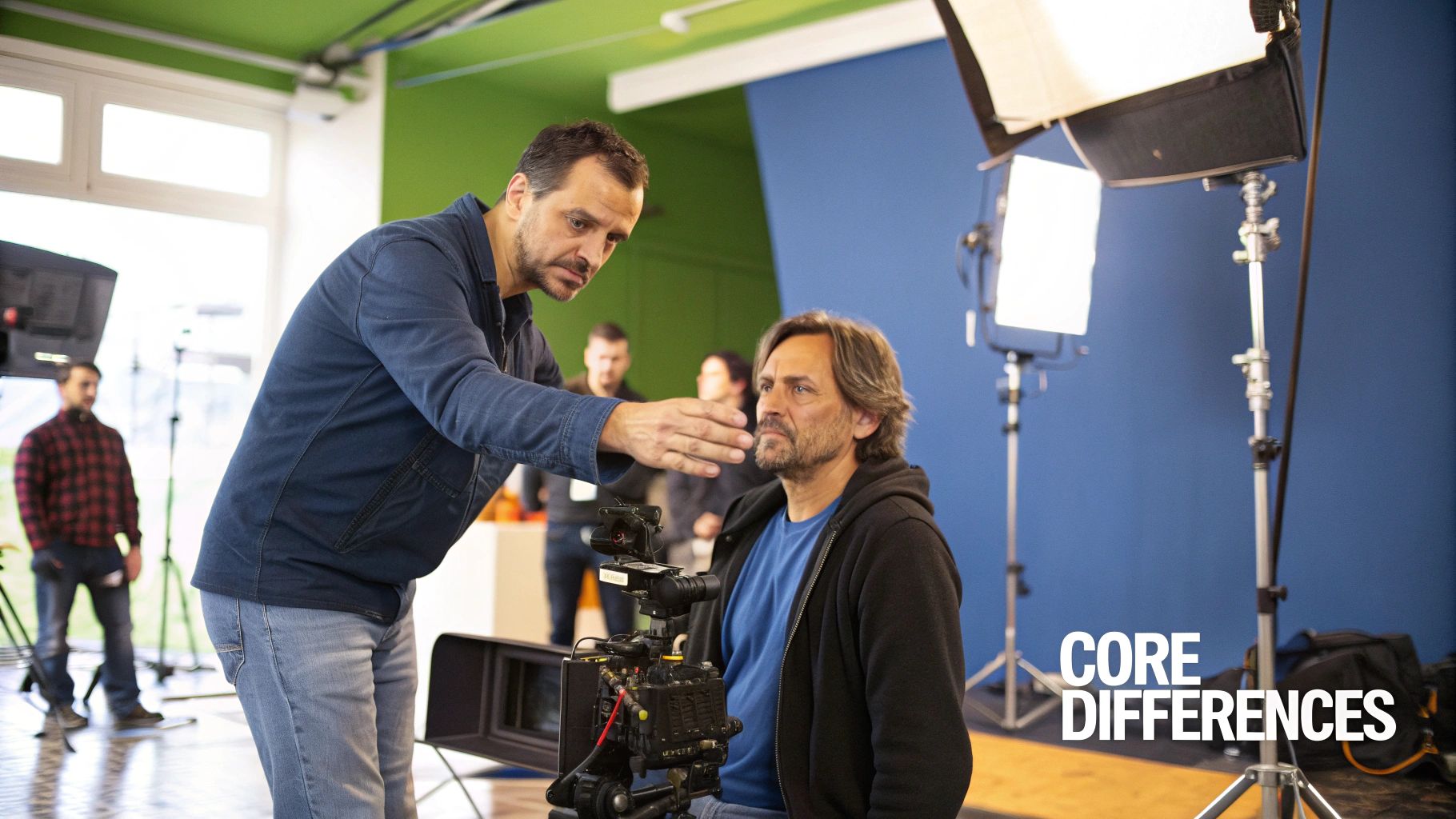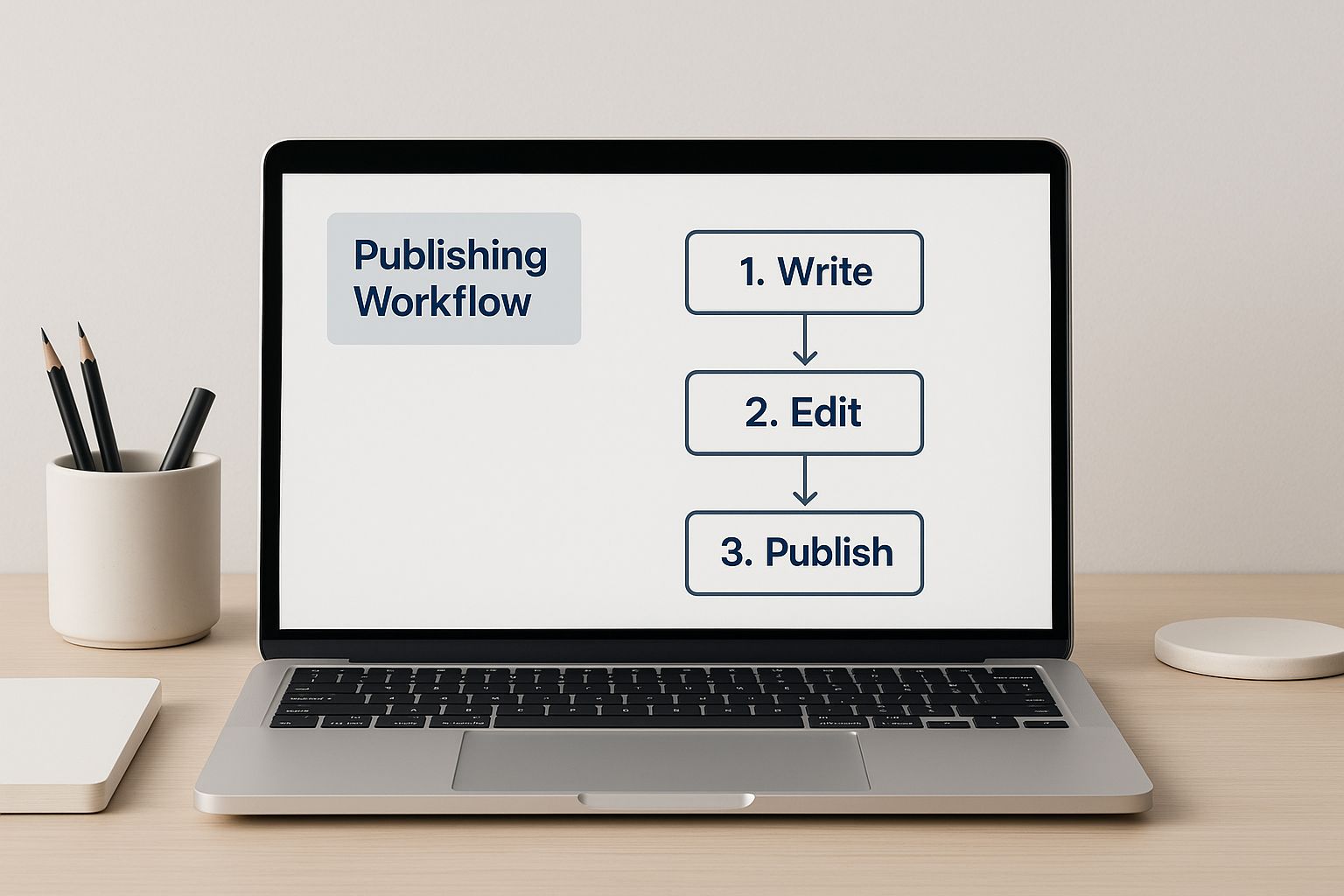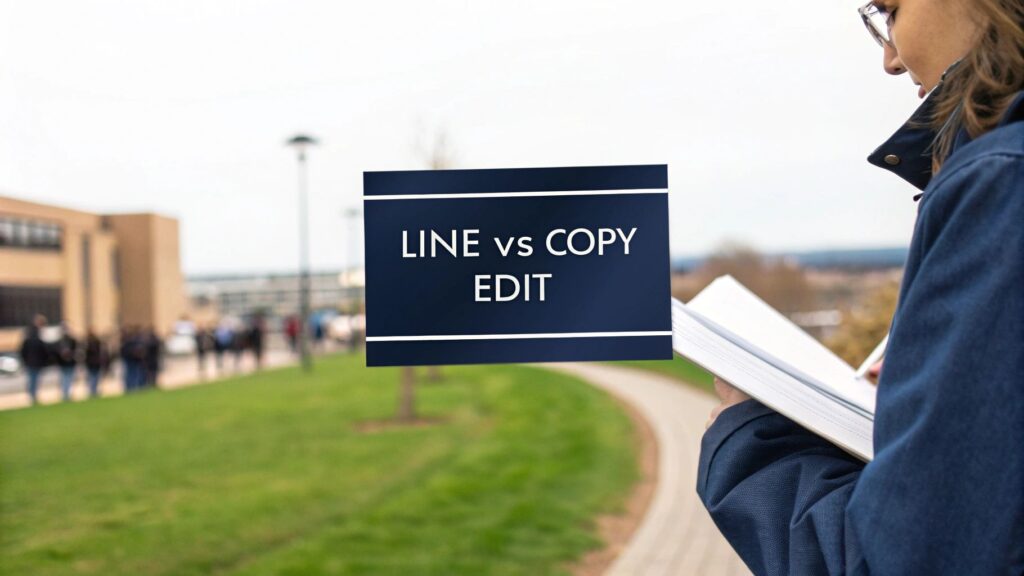It's a question I hear all the time: "What's the real difference between a line edit and a copy edit?" The simplest way to put it is this: line editing is art, while copy editing is science.
A line edit digs into the creative soul of your writing—the flow, rhythm, and emotional punch of every single sentence. On the other hand, a copy edit is all about technical precision. It’s the final polish that corrects grammar, spelling, punctuation, and consistency, making sure your manuscript is clean and professional.
Understanding the Core Differences

While both types of editing happen at the sentence level, they have very different jobs. I like to think of a line editor as a director coaching an actor on their performance. They’re focused on refining the delivery, tone, and emotional impact.
The copy editor? They’re the continuity expert on set, making sure every last detail is technically perfect before the final cut.
This isn't a new distinction. Line editing grew out of the need to shape an author's style and narrative flow. Copy editing has always been the more mechanical process, focused on applying the rules from a style guide. It’s no surprise that over 60% of professional editors specialize in one or the other; the skill sets are genuinely that different.
Key Takeaway: You hire a line editor to make your prose sing. You hire a copy editor to make sure it's grammatically flawless. One refines your voice, the other guarantees your professionalism.
Knowing which one you need at which stage is crucial. It also helps you see how these services fit into the larger publishing picture, which you can read more about in our guide to proofreading vs editing.
Line Editing vs Copy Editing At a Glance
To really break it down, a side-by-side comparison is often the clearest way to see how a line edit vs copy edit tackles different parts of a manuscript.
This table gives you a snapshot of what each service truly focuses on.
| Aspect | Line Editing (The Art) | Copy Editing (The Science) |
|---|---|---|
| Primary Goal | Enhance style, voice, flow, and readability | Ensure correctness, clarity, and consistency |
| Focus Area | Word choice, sentence structure, tone, pacing | Grammar, spelling, punctuation, syntax |
| Questions Asked | "Does this sentence flow well?" "Is this the best word?" | "Is this comma used correctly?" "Is this consistent?" |
| Analogy | A vocal coach refining a singer's performance | A sound engineer fixing technical audio issues |
Ultimately, one process hones your unique style, while the other ensures your work meets professional publishing standards.
Scope and Focus: A Side-by-Side Look
When you get down to it, the real difference between a line edit and a copy edit isn't just a simple definition. It's about the lens each editor uses to look at your manuscript. One is focused on the artistry of your prose, while the other is all about technical precision.
Think of it this way: a line editor is like a master craftsman sanding and polishing a beautiful piece of wood, bringing out the unique grain and texture. A copy editor is the finisher, applying a perfect, protective coat that makes the final product flawless. Both are essential, but they work on entirely different levels.
The Artistic Focus of a Line Edit
A line editor dives deep into the craft of your writing. Their work is much more stylistic, almost subjective. They're not just asking, "Is this sentence correct?" They’re asking, "Is this sentence working?" Their goal is to take your writing from good to unforgettable.
Here’s what a line editor is looking for:
- Word Choice: Are you using the most powerful words? They might swap out a simple "walked" for a more descriptive "shuffled," "strode," or "scampered" to inject more meaning and character into the action.
- Sentence Rhythm and Flow: They hunt for clunky phrasing or repetitive sentence structures that can make your prose feel monotonous. They might combine short, choppy sentences to create a smoother flow or break up a long one to add punch.
- Tone and Voice: A line editor makes sure the tone of your writing matches the scene's emotional weight and, most importantly, that your unique authorial voice is coming through loud and clear. If a character’s dialogue feels stiff or out of place, they’ll point it out.
- Clarity and Conciseness: This is about trimming the fat. They’ll cut redundant words and rephrase confusing passages to make your ideas land with absolute clarity.
A line editor is constantly asking, "Does this sentence resonate emotionally? Is there a more powerful way to say this? Does the prose sing?" Their goal is to make every line a pleasure to read.
Let's see this in action.
Before Line Edit:
The man went into the dark room very cautiously because he was scared of what might be in there.
After Line Edit:
He crept into the blackness, his heart hammering against his ribs. What waited in the shadows?
Notice the change? The second version isn't just grammatically correct; it's alive. It uses stronger verbs ("crept"), visceral details ("heart hammering"), and a gripping question to pull the reader right into the character's fear. That transformation is the very soul of line editing. If you want to dig deeper, you can learn more about what line editing truly involves in our detailed guide.
The Technical Precision of a Copy Edit
While the line editor is busy with the art, the copy editor is all about the science. Their job is to make sure your manuscript is technically perfect and follows the established rules of the written word. They are your last line of defense against embarrassing errors.
A copy editor's work is meticulous, objective, and almost always guided by a specific style manual, like The Chicago Manual of Style. They are the guardians of correctness.
Their checklist is all about the nuts and bolts:
- Grammar: This is the big one. They'll fix everything from subject-verb agreement and pronoun misuse to dangling modifiers.
- Spelling and Punctuation: They are hawks for typos and ensure every comma, semicolon, and apostrophe is exactly where it should be according to the style guide.
- Syntax: They’ll correct awkward sentence structures, but from a purely mechanical and grammatical standpoint, not a stylistic one.
- Consistency: This is a huge part of their job. Did you spell a character's name "Sara" in chapter 2 and "Sarah" in chapter 15? They’ll catch it. They track everything from capitalization rules to hyphenation to ensure it’s consistent from page one to the end.
A copy editor’s primary mission is to remove any technical distraction that could pull a reader out of your story. They make sure the rules are followed so your narrative can shine without a single hiccup.
Where Each Edit Fits in the Publishing Workflow
Every author wants a polished, professional book, but getting there requires a clear roadmap. The editing timeline isn't just a suggestion; it's a critical sequence that saves you from costly rework and headaches. A huge point of confusion for many writers is figuring out where line editing vs. copy editing fits into this process.
Here’s the golden rule: a line edit always comes before a copy edit.
Why? Think about it this way: you wouldn't pay someone to meticulously polish the grammar on sentences that a line editor might completely overhaul for rhythm and impact. That's like washing and waxing a car before the mechanic has even pulled out the major dents. It just doesn't make sense.
This infographic breaks down the standard publishing journey, showing how each stage logically builds on the last.

As you can see, the entire process is about zooming in, moving from the big-picture story down to the tiniest of details.
The Standard Editorial Sequence
The path from a rough first draft to a book-in-hand follows a well-trodden, logical order. Each step narrows the focus, making sure the core elements are solid before you start polishing individual sentences. This tiered approach prevents you from having to backtrack and ensures every editor's time is used effectively.
Here’s how the typical workflow unfolds:
- Developmental Editing: This is the 10,000-foot view. A developmental editor tackles the "big picture" stuff—plot holes, character development, pacing, overall structure, and theme. This is where major rewrites and foundational changes happen.
- Line Editing: With a solid story in place, the line editor comes in. They dive into the craft of your prose, working line-by-line to sharpen your voice, smooth out clunky sentences, and punch up the emotional impact of your writing.
- Copy Editing: Once your style and voice are singing, the copy editor gets to work. Their role is purely technical, hunting down errors in grammar, spelling, punctuation, and syntax. They also enforce consistency, often using a style guide like The Chicago Manual of Style.
- Proofreading: This is the final pre-flight check. After the manuscript is designed and formatted for print or digital, a proofreader scours the pages for any leftover typos, formatting glitches, or embarrassing mistakes that slipped through. It's your last line of defense before hitting "publish."
Key Insight: Following this sequence is non-negotiable in professional publishing. Trying to skip a step or doing them out of order is the surest way to let errors fall through the cracks, damaging your credibility with readers.
When you respect this workflow, each round of editing builds on the last. You start by building a strong story structure, then you refine the artistry of your prose, correct all the technical mistakes, and finish with a final quality check. It’s the proven path to creating a book that's not only a great read but also professionally presented.
Comparing Costs and Timelines for Authors

For any author, the practicalities of money and time are just as real as the creative work itself. To plan a successful publication, you have to understand what a line edit vs copy edit will actually cost you—both in dollars and in days. The two services are worlds apart in this regard, and it all comes down to the kind of work being done.
Think of it this way: line editing is a deeply subjective, artistic process. The editor is wrestling with your style, rhythm, and voice. That takes time and a very particular skill set. Copy editing, on the other hand, is more objective. It’s about applying established rules, which makes for a more straightforward and often faster workflow.
Breaking Down the Costs
Most editors price their work either per word or by the hour. A per-word rate gives you a fixed cost upfront, which is great for budgeting. An hourly rate, however, reflects the actual time your manuscript demands. Because of its intense, creative nature, line editing will almost always be the more expensive of the two.
The Editorial Freelancers Association’s 2023 rate chart really puts this into perspective. Median hourly rates for a line editor hover around $45–$60, while a copy editor typically falls between $30–$45. It makes sense—polishing prose to make it sing requires a different level of engagement than correcting grammar. For a deeper dive into the numbers, check out our guide on how much book editing costs.
Key Financial Insight: As a rule of thumb, expect to budget 25–50% more for a line edit than you would for a copy edit. You're not just paying for corrections; you're investing in the kind of deep stylistic polish that elevates the reading experience and can make your book stand out.
Of course, the final quote you get for either service will depend on a few things:
- Manuscript Complexity: A dense academic text or a literary novel packed with intricate prose is a heavier lift than, say, a straightforward contemporary romance. More complexity means more time and a higher cost.
- Editor Experience: A veteran editor with a killer portfolio and glowing testimonials will rightly charge more than someone just starting out.
- Genre: If your book is in a niche like hard sci-fi or meticulously researched historical fiction, you’ll need an editor with specialized knowledge, which can also influence the price.
Projecting Your Editing Timeline
Time is the other resource you can't get back. A copy edit is almost always the faster of the two because the editor is working from a clear checklist of grammatical and stylistic rules.
A line edit is a different beast entirely. It demands that the editor sink into your narrative voice and weigh the artistic impact of every single sentence. That’s a slow, deliberate dance.
For an 80,000-word manuscript, a copy edit might take anywhere from two to four weeks. That same manuscript could easily need four to six weeks for a thorough line edit. That extra time is where the magic happens—it’s the deep, thoughtful engagement that refines your prose until it shines. Interestingly, a 2020 analysis found that while 92% of editing requests were for copy editing, only 58% were for line editing. This suggests many authors focus on technical correctness, but those who invest in stylistic refinement often see a much bigger impact on their final product.
How to Choose the Right Edit for Your Manuscript
Trying to decide between a line edit vs copy edit can feel like you're trying to diagnose your car's engine trouble by listening to it. You know something's not quite right, but what? Both services deal with your sentences, but picking the right one at the right time is crucial for making a smart investment in your book. The choice really boils down to the current shape of your manuscript and how confident you are in your prose.
A great first step is to get some honest feedback. If your beta readers are saying things like, "the writing felt a little flat," "the dialogue didn't sound real," or "I lost your voice in this chapter," you've got some pretty clear signals. Those are all symptoms that point toward a need for stylistic work—a line edit.
But if the feedback is strong on style and voice, and your real fear is about those sneaky typos, grammatical errors, or continuity slip-ups you know are lurking in there, then you're looking at a technical problem. Getting the diagnosis right saves you from paying for a treatment you don't need.
Diagnosing Your Manuscript
The best way to figure this out is to do a little self-assessment. Be honest with yourself and ask some direct questions about your writing. Your answers will paint a clear picture of what your manuscript really needs, guiding you toward either the artistic polish of a line edit or the technical cleanup of a copy edit.
Let’s look at a few common author scenarios:
- The Debut Novelist: If you're new to this, you'll probably get a lot out of both. A line edit is invaluable for helping you find and sharpen your unique authorial voice—a skill that can take years to nail down. Following that up with a copy edit makes sure the final product is truly professional.
- The Seasoned Author: A writer with a few books under their belt and a well-defined style might just need that final polish. If you’re confident in your prose, you might be ready to jump straight to a copy edit to catch any objective errors before you hit publish.
- The Non-Fiction Expert: For anyone whose main goal is to make complex information easy to digest, a line edit can be a game-changer. It helps ensure your sentences aren't just grammatically correct, but are also clear, punchy, and engaging enough to keep your reader from tuning out.
Key Insight: Don't just guess which edit you need. The feedback you get from trusted readers is your best diagnostic tool. Pay close attention to comments about how the story reads, not just what happens in the plot.
Your Diagnostic Checklist
To make this a bit more concrete, here's a little checklist to help. Think about the feedback you've received or the issues you've noticed yourself, and see which service lines up. This should take most of the guesswork out of the line edit vs copy edit decision.
Here's a quick guide to help you match your manuscript's symptoms with the right kind of editorial care.
Which Editing Service Does Your Manuscript Need?
| Manuscript Symptom | Recommended Service |
|---|---|
| Dialogue sounds stiff or characters sound the same. | Line Edit |
| You worry about comma splices and dangling modifiers. | Copy Edit |
| Readers say some passages are confusing or hard to follow. | Line Edit |
| You're unsure if you've capitalized terms consistently. | Copy Edit |
| Your prose feels wordy or uses too many clichés. | Line Edit |
| You're confident in your style but know typos are your weakness. | Copy Edit |
Ultimately, choosing the right service is all about understanding where your manuscript is in its journey. A line edit is like shaping the clay on the potter's wheel, while a copy edit is like applying the final, protective glaze. When you accurately assess your work, you can be sure it gets exactly the kind of polish it needs to really shine.
A Few Common Questions About Editing
Once you get a handle on the theory behind line editing vs. copy editing, the practical questions usually start popping up. Moving from understanding the difference to actually applying it to your manuscript is where authors often get stuck. Let's tackle some of the most common queries I hear to give you some clear, straightforward advice.
The idea here is to help you clear away any final confusion so you can choose the right editor for your book with total confidence.
Can One Editor Handle Both Services?
Absolutely. Many experienced freelance editors offer both line editing and copy editing, and they often package them together. But—and this is a big "but"—it's critical to know they are still two very different jobs.
When a professional offers a combined service, they should always do the line edit first. That's the part where they dig into your style, rhythm, and the overall feel of your prose. Only after you've reviewed and signed off on those creative changes should they put on their copy editor hat. Then, they'll comb through the manuscript for all the technical stuff: grammar, punctuation, and consistency. Make sure you confirm this two-step workflow with any editor you hire.
Key Takeaway: Even if the same person does both, a line edit and a copy edit are separate tasks performed in a specific order. The creative work must come before the technical polish.
When Is It Okay To Skip a Line Edit?
Look, if you're a seasoned author with a distinctive voice that you've honed over many books, you might be able to get away with it. If you are absolutely certain your prose is crisp, your dialogue sings, and your authorial voice is rock-solid from start to finish, then jumping straight to a copy edit could be a reasonable choice.
For almost everyone else, though? The line edit is essential. This is especially true for writers who are still finding their footing. A line edit is what takes a good story and makes it an experience for the reader. Think of it as an investment in the immersive power of your writing—one that will pay off massively in reader engagement.
How Do These Edits Differ From Developmental Editing?
I find it helpful to imagine the editing process like a funnel. You start with the big, wide-open view and gradually narrow your focus down to the tiniest details.
- Developmental Editing: This is the top of the funnel, the widest part. Your editor is looking at the "big picture" stuff—plot holes, character development, overall structure, and the story's pacing.
- Line Editing: Now we're in the middle of the funnel. The focus tightens to the paragraph and sentence level. It's all about improving style, flow, and the emotional impact of your writing.
- Copy Editing: This is the very bottom, the narrowest point of the funnel. It's that final, meticulous check for grammar, spelling, punctuation, and any lingering inconsistencies.
Each stage logically follows the one before it. You have to make sure the foundation is solid before you start polishing the walls.
Ready to transform your manuscript into a professionally published book? BarkerBooks has helped over 7,500 authors bring their stories to life with expert editing, design, and global distribution. Discover our comprehensive publishing packages and start your journey today.
